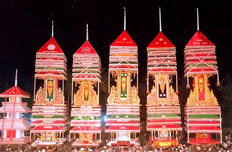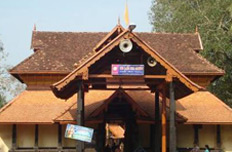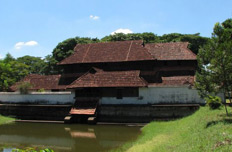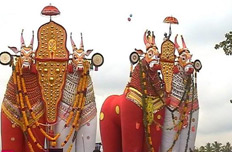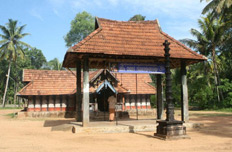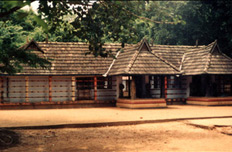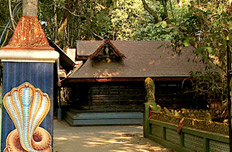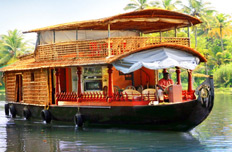TOURIST ATTRACTIONS
Chettikulangara Kumbha Bharani
Chettikulangara Kumbha Bharani is an important festival celebrated every year at the Chettikulangara Devi Temple, Chettikulangara, Alappuzha district, Kerala. It is held is in the month of March or April, the date being determined according to the Malayalam Calendar. Chettikulangara Bharani in the Bharani nakshatra in the Malayalam month of Kumbha and hence the name Kumbha Bharani. Kuthiyottam and Kettukazhcha are the highlights of the festival. The festival is under consideration to be bestowed with the Intangible Cultural Heritage status by UNESCO.
Kandiyoor Sree Mahadeva Temple
Kandiyoor Sree Mahadeva Temple is an ancient Shiva temple situated in Kandiyoor near Mavelikara on the banks of Achankovil River. Kandiyoor was once the capital of the Odanadu kingdom. It is one among the 108 great Shiva temples of ancient Kerala consecrated by Lord Parashurama himself. The temple is 1 kilometre (0.62 mi) west of Mavelikar town north of Sate Highway 6. It is spread across an area of 7.5 acres.The Kandiyoor temple is the earliest temple about which there is an epigraph about its origin in A.D 823 during the reign of Rajasekhara Varman
Krishnapuram Palace
The Krishnapuram Palace is a palace and museum located in Kayamkulam near Alappuzha in Alappuzha district, Kerala in southwestern India. It was built in the 18th century by Anizham Thirunal Marthanda Varma (1729–1758 AD), the Travancore kingdom. It is built in the architectural style of Kerala with gabled roof, narrow corridor and dormer windows, near the Krishnaswamy Temple at Krishnapuram.It is also said that an underground escape route runs from the bottom of the pond as a possible escape route from enemies.
Oachira Temple
The Oachira Temple is an extremely ancient temple located in Oachira in Kollam district in the South Indian state of Kerala. According to the Puranas, this temple is one of the famous sacred places of Kerala and India.Oachira is on the border of Kollam and Allappuzha districts, next to the National Highway 47. This very ancient pilgrimage center is centered on the ParaBrahma temple (that is dedicated to the Para Brahman (or Param Brahman) or Ohmkaram, the Universal Consciousness), and covers thirty-six acres of land.
Sri Krishna swami Temple
The holy and ancient Sri Krishna swami Temple is at the heart of the Mavelikara town and it faces towards the east. The main deity of this temple is the idol of Sri Krishna with both hands stretching out for butter. Centuries ago, this temple had belonged to the Idaserry Family. At the portal of the temple with architectural beauty, in the east, the temple guards made of flint are on guard duty.It is a historic truth that Mavelikara, which was the citadel of the Madathinkore royal family, had been a vassal of the Onattukara Kingdom.
Vetticode Sree Nagarajaswami Temple
As per the legend Sree Nagaraja Swami Temple at Vetticode was consecrated by Lord Parasurama. The temple located near Kayamkulam in Alappuzha district of Kerala is visited by hundreds of devotees on a daily basis.
Located on a six-acre land in the midst of a lush green environment, the Sarppakkavu (serpent grove) here has Nagaraja and Nagayakshi as the principal deities. It is a haven not only for the snakes, but also for several varieties of birds.
Mannarasala Temple
Though the legends related to the origin of a place cannot be deemed as its history, the story on the evolution of Mannarasala as the supreme place of worship of the serpent Gods is associated with Parasurama, the creator of Kerala. The history of Mannarasala has been mentioned in the 'Mandara Salodayam' Sanskrit poem written by Mannarasala M.G.Narayanan Nampoodiri of the sacred family, who wrote it on the basis of reliable accounts and legends traditionally handed down and in the light of old books available with the temple
Alappuzha houseboat
The Houseboats of Kerala are a new addition to the travel and tourism of the state's backwaters. These crafts, measuring up to 120 feet in length, retrieved from the age old cargo vessels of the State. Once they ruled the backwaters, poled along by one or two men, heavily loaded with rice, coconut and other commodities. But in the recent times, these big vessels have been replaced by more and modern modes of transport, relegating them to neglect and decay.


